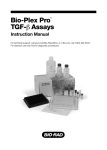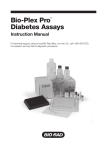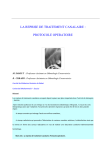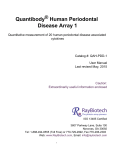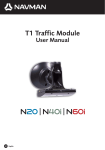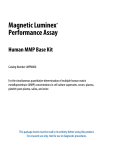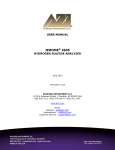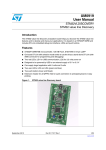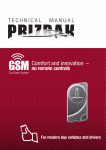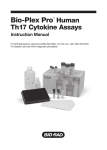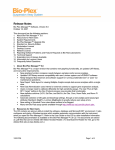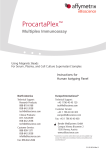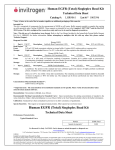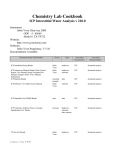Download Instruction manual - Bio-Rad
Transcript
Bio-Plex Pro Human MMP Assays ™ Instruction Manual For technical support, call your local Bio-Rad office, or in the U.S., call 1-800-424-6723. For research use only. Not for diagnostic procedures. Table of Contents Introduction1 Principle2 Kit Contents and Storage 4 Recommended Materials 5 Assay Workflow 6 lmportant Considerations 7 Detailed Instructions 7 1.1. Plan Plate Layout8 2.2. Prepare Instrument9 3.3. Prepare Wash Method10 4.4. Preparing Buffer and Diluent11 55. Prepare Standards and Controls12 6. Prepare Samples14 7.7. Prepare Coupled Beads16 88. Run Assay18 99. Read Plate22 Troubleshooting Guide 29 Plate Layout Template 34 Calculation Worksheet 35 Safety Considerations 37 Legal Notices 37 Ordering Information 38 Introduction The matrix metalloproteinases (MMPs) are a family of 24 zinc proteases with essential roles in breaking down components of the extracellular matrix (ECM). MMPs play important roles in tissue remodeling associated with various physiological and pathological processes such as morphogenesis, angiogenesis, tissue repair, cirrhosis, arthritis, and metastasis. MMPs’ substrates include ECM components, cytokines, chemokines, growth factors and binding proteins, cell/cell adhesion molecules, and other proteinases. The MMPs are inhibited by specific endogenous tissue inhibitors of metalloproteinases (TIMPs). Multiplexing with Bio-Plex Pro MMP Assays Bio-Plex Pro MMP assays enable researchers to quantify multiple protein biomarkers in a single well of a 96-well plate in just 3–4 hours. These robust immunoassays require as little as 5 μl of serum or plasma or 50 μl of other biological fluid. The use of magnetic (MagPlex) beads allows researchers to automate wash steps on a Bio-Plex Pro (or similar) wash station. Magnetic separation offers greater convenience and reproducibility compared to vacuum filtration. For more information, please visit www.bio-rad.com/bio-plex. 1 Principle Technology The Bio-Plex® multiplex system is built upon the three core elements of xMAP technology: n n n Fluorescently dyed magnetic microspheres (also called beads), each with a distinct color code or spectral address to permit discrimination of individual tests within a multiplex suspension. This allows simultaneous detection of up to 500 different molecules in a single well of a 96-well microplate on the Bio-Plex® 3D system, up to 100 different molecules on the Bio-Plex® 200 system, and up to 50 different molecules on the Bio-Plex® MAGPIX™ system A dedicated plate reader. The Bio-Plex 200 and Bio-Plex 3D systems are flow cytometry–based instruments with two lasers and associated optics to measure the different molecules bound to the surface of the beads. In the Bio-Plex MAGPIX system, the sample is injected into a chamber where the beads are imaged using LED and CCD technology A high-speed digital signal processor that efficiently manages the fluorescence data Assay Format Bio-Plex Pro™ assays are essentially immunoassays formatted on magnetic beads. The assay principle is similar to that of a sandwich ELISA (Figure 1). Capture antibodies directed against the desired biomarker are covalently coupled to the beads. Coupled beads react with the sample containing the biomarker of interest. After a series of washes to remove unbound protein, a biotinylated detection antibody is added to create a sandwich complex. The final detection complex is formed with the addition of streptavidin-phycoerythrin (SA-PE) conjugate. Phycoerythrin serves as a fluorescent indicator, or reporter. 2 Biomarker of Interest Streptavidin Magnetic Bead Capture Antibody Biotinylated Detection Antibody Phycoerythrin Fluorescent Reporter Fig. 1. Bio-Plex sandwich immunoassay. Data Acquisition and Analysis Data from the reactions are acquired using a Bio-Plex system or similar Luminex-based reader. When a multiplex assay suspension is drawn into the Bio-Plex 200 reader, for example, a red (635 nm) laser illuminates the fluorescent dyes within each bead to provide bead classification and thus assay identification. At the same time, a green (532 nm) laser excites PE to generate a reporter signal, which is detected by a photomultiplier tube (PMT). A high-speed digital processor manages data output, and Bio-Plex Manager™ software presents data as median fluorescence intensity (MFI) as well as concentration (pg/ml). The concentration of analyte bound to each bead is proportional to the MFI of reporter signal. Using Bio-Plex Data Pro™ software, data from multiple instrument runs can be combined into a single project for easy data management, quick visualization of results, and simple statistical analysis. 3 Kit Contents and Storage Reagents Supplied Bio-Plex Pro™ human MMP assays are available in a convenient all-inone kit format that includes assay, reagent, and diluent components in a single box. Table 1. Contents of 1 x 96-well kits. Component Quantity** Coupled magnetic beads (20x) 1 tube Detection antibodies (20x) 1 tube Standards 1 vial 1 vial Control* Sample diluent HB 1 bottle (30 ml) Detection antibody diluent HB 1 bottle (3.5 ml) Standard diluent HB 1 bottle (10 ml) Assay buffer 1 bottle (50 ml) Wash buffer (10x) 1 bottle (60 ml) Streptavidin-PE (100x) 1 tube Assay plate (96-well flat bottom plate) 1 plate Sealing tape 1 pack of 4 Assay quick guide 1 booklet Product data sheet 1 sheet * Provided with the 9-plex fixed panel only. ** Volumes shown are approximate. Storage and Stability Kit contents should be stored at 4°C and never frozen. Coupled magnetic beads and streptavidin-PE should be stored in the dark. All components are guaranteed for a minimum of six months from the date of purchase when stored as specified. 4 Table 2. Recommended materials. Item Ordering Information Bio-Plex Pro MMP Assays Quick Guide Bulletin #10041637 (download at www.bio-rad.com/bio-plex) Bio-Plex® MAGPIX™, 200 system or Luminex system with HTF Bio-Rad catalog #171-000205 Bio-Plex validation kit Note: Run the validation kit monthly to ensure optimal performance of fluidics and optics systems Bio-Rad catalog #171-203001 Bio-Plex calibration kit Note: Run the calibration kit daily to standardize fluorescence signal Bio-Rad catalog #171-203060 Bio-Plex Pro wash station For use with magnetic bead–based assays only Bio-Rad catalog #300-34376 Bio-Plex handheld magnetic washer For use with magnetic bead–based assays only Bio-Rad catalog #170-20100 Bio-Plex Pro flat bottom plates (40 x 96-well) For magnetic separation on the Bio-Plex Pro wash station Bio-Rad catalog #171-025001 Titertube® micro test tubes For preparing replicate standards, samples, and controls prior to loading the plate Bio-Rad catalog #223-9390 Microtiter plate shaker IKA MTS 2/4 shaker for 2 or 4 microplates or Barnstead/Lab-Line Model 4625 plate shaker (or equivalent capable of 300–1,100 rpm) IKA catalog #320-8000 VWR catalog #57019-600 Aurum™ vacuum manifold For vacuum filtration Bio-Rad catalog #732-6470 BR-2000 vortexer Bio-Rad catalog #166-0610 Reagent reservoirs, 25 ml For capture beads and detection antibodies VistaLab catalog #3054-1002 or VistaLab catalog #3054-1004 Reagent reservoir, 50 ml (for reagents and buffers) VistaLab catalog #3054-1006 Pall Life Science Acrodisc: 25 mm PF syringe filter (0.8/0.2 µm Supor membrane) Pall Life Sciences catalog #4187 Filter plate, 1 x 96 with clear plastic lid and tray Bio-Rad catalog #171-304502 Bio-Plex Manager™ MP Software Upgrade Bio-Rad catalog #171-051555 Other: 15 ml polypropylene tubes for reagent dilutions, calibrated pipets, pipet tips, sterile distilled water, aluminum foil, absorbent paper towels, 1.5 or 2 ml microcentrifuge tubes, and standard flat bottom microplate (for calibrating vacuum manifold). 5 Assay Workflow Prewet wells (for filter plate only) Add 50 μl 1x beads to wells Wash 2 x 100 μl Add 50 μl standards, samples, controls; incubate on shaker at 850 rpm for 1 hr at RT Wash 3 x 100 μl Add 25 μl 1x detection antibody; incubate on shaker at 850 rpm for 30 min at RT Wash 3 x 100 μl Add 50 μl 1x streptavidin-PE; incubate on shaker at 850 rpm for 10 min at RT Wash 3 x 100 μl Resuspend in 125 μl assay buffer, shake at 850 rpm for 30 sec Acquire data on Bio-Plex system 6 lmportant Considerations Instruments and Software The Bio-Plex Pro™ assays described in this manual are compatible with all currently available Luminex-based life science research instruments. Assays can be read and analyzed with either Bio-Plex Manager™ software or Luminex xPonent software (see the Run Assay section). Assay Procedures Please pay close attention to vortexing, shaking, and incubation times and to Bio-Plex® reader PMT (RP1) setting, as these have been optimized specifically for each assay panel. Assay Quick Guide Each assay kit comes complete with a printed Bio-Plex Pro™ Assay Quick Guide (bulletin #10041637), which can be used to prepare and run a full 1 x 96-well assay plate. Users can also download a copy at www.bio-rad.com/bio-plex. Bead Regions and Multiplexing Compatibility n n n B ead regions for all analytes are listed in the Read Plate section o not mix analytes between different Bio-Plex panels or reagent kits. D Resulting standard curves and sample values may be inaccurate here is a small chance of cross-reactivity caused by MMP-13 in EDTAT plasma from cancer patients* * In a small study (N=17) of breast and colon cancer samples, MMP-13 showed cross-reactivity in four EDTA-plasma samples (24%) and none in the matching serum samples. Therefore, it is recommended not to mix MMP-13 with any other assays when testing EDTA-plasma cancer samples. Use only one type of matrix in each study to ensure data continuity, placing emphasis on consistency in sample collection, preparation and storage. Detailed Instructions The following pages provide detailed instructions for each step of the assay procedure, including preparation, running the assay, and reading the plate with Bio-Plex Manager™ and Luminex xPonent software. 7 1. Plan Plate Layout Determine the total number of wells in the experiment using the Plate Layout Template on page 34 or the Plate Formatting tab in Bio-Plex Manager™. A suggested plate layout is shown in Figure 2, with all conditions in duplicate. 1.Assign standards to columns 1 and 2, with the highest concentration in row A and the lowest concentration in row H. 2.Assign the blank to wells A3 and A4. The blank should consist of your chosen standard diluent HB. Note that Bio-Plex Manager automatically subtracts the blank (B) MFI value from all other assay wells. 3.User-specified controls, as well as the controls supplied in premixed kits, are assigned to wells in columns 3 and 4. 4. The remainder of the plate is available for samples. 5. Once the total number of wells is known, you can calculate the required volumes of beads, detection antibody, and streptavidin-PE. Use Tables 6–7, 9–10, and 11, respectively, or the Calculation Worksheet on pages 35–36. Legend S Standard B Blank X Samples C Controls Fig. 2. Suggested plate layout. For detailed instructions on plate formatting in Bio-Plex Manager, see the Read Plate section. 8 2. Prepare Instrument These directions are specific for the Bio-Plex® 100/200 reader. To prepare either a Bio-Plex 3D or Bio-Plex® MAGPIX™ reader, consult their respective user manuals. Note: While the instrument is warming up, bring the 10x wash buffer, assay buffer, and diluents to room temperature. Keep other items on ice until needed. Also, begin to thaw frozen samples. Start up and calibrate the Bio-Plex system with Bio-Plex Manager™ software prior to setting up the assay. The calibration kit should be run daily or before each use of the instrument to standardize the fluorescent signal. For instructions on using other xMAP system software packages, contact Bio-Rad Technical Support. The validation kit should be run monthly to ensure optimal performance of fluidics and optics systems. Refer to either the software manual or online Help for directions on how to conduct validation. Start Up System (Bio-Plex 100, 200, or similar) 1.Empty the waste bottle and fill the sheath fluid bottle before starting if high throughput fluidics (HTF) are not present. This will prevent fluidic system backup and potential data loss. 2.Turn on the reader, XY platform, and HTF (if included). Allow the system to warm up for 30 min (if not already done). 3.Select Start up and follow the instructions. If the system is idle for 4 hr without acquiring data, the lasers will automatically turn off. To reset the 4-hr countdown, select Warm up and wait for the lasers/optics to reach operational temperature. 9 Calibrate System 1.Select Calibrate and confirm that the default values for CAL1 and CAL2 are the same as the values printed on the bottle of Bio-Plex calibration beads. Use the Bio-Plex system low RP1 target value. 2.Select OK and follow the software prompts for step-by-step instructions for CAL1 and CAL2 calibration. Note: In Bio-Plex Manager version 6.1 and higher, startup, warm up, and calibration can be performed together by selecting the Start up and calibrate icon. 3. Prepare Wash Method Bio-Plex Pro™ assays are compatible with both magnetic separation and vacuum filtration methods. However, for best results, we recommend performing the assays in a flat bottom plate with magnetic separation. Table 3. Summary of compatible wash stations and plate types. Wash Method Wash Station Assay Plate Magnetic separation Bio-Plex Pro Bio-Plex® handheld magnetic washer Flat bottom plate Vacuum filtration Vacuum manifold (manual) Filter plate Setting Up the Bio-Plex Pro Wash Station The wash station should be primed before use. For more information, refer to the Bio-Plex Pro Wash Stations Quick Guide (bulletin #5826). 1.Install the appropriate plate carrier on the wash station. 2. Use the Prime procedure to prime channel 1 with 1x wash buffer. 10 Setting Up the Bio-Plex Handheld Magnetic Washer Place an empty flat bottom plate on the magnetic washer by sliding it under the retaining clips. Push the clips inward to secure the plate. Make sure the plate is held securely. If needed, the clips can be adjusted for height and tension. For detailed instructions, refer to the user guide (bulletin #10023087). Setting Up a Vacuum Manifold Calibrate the vacuum manifold by placing a standard 96-well flat bottom plate on the unit and adjusting the pressure to –1 to –3" Hg. In general, 100 µl liquid should take 3–4 sec to clear the well. For more detailed instructions, refer to bulletin #10005042. 4. Preparing Buffer and Diluent Prepare Wash Buffer 1.Bring the 10x stock solution to room temperature. 2.If crystals are present, ensure that they are completely dissolved. Mix the 10x stock solution by inversion before preparing the 1x wash buffer. 3. To prepare 1x wash buffer, dilute 1 part 10x stock solution with 9 parts deionized water. Prepare 10% Serum-Based Standard Diluent 1.Bring the standard diluent HB to room temperature. 2.To prepare 10% serum-based standard diluent, dilute 1 part standard diluent HB with 1.5 parts sample diluent HB (for example, add 4 ml standard diluent HB to 6 ml sample diluent HB). 11 5. Prepare Standards and Controls General Instructions n n It is essential to prepare standards and controls (if included) exactly as described in this section. Incorrect preparation may lead to low signal or variable measurements from plate to plate The product data sheet provided with the standards lists the most concentrated point on the standard curve (S1). Enter this information into Bio-Plex Manager™ software as instructed in section 9 Using the Controls (optional) A single vial of controls is provided with the 9-plex fixed panel only. Their use is intended for monitoring the day-to-day quality of assay results. Selecting a Diluent for Standards and Controls Refer to Table 4 for recommended diluents based on different sample types. In order to meet the lot-specific control ranges provided on the product data sheet, both the standards and controls should be reconstituted in Bio-Plex® standard diluent HB. If reconstituting in a different diluent, users will need to establish/validate their own control ranges or acceptance criteria. Table 4. Summary of recommended diluents for standards and controls. Diluent for Standards Sample Type and Controls* Add BSA Serum and plasma 10% serum-based standard diluent None Culture media, with serum Culture medium None Culture media, serum-free Culture medium To 0.5% final** Lavage, sputum, other fluids Sample diluent HB To 0.5% final** * If using diluents other than 10% serum-based standard diluent, users must establish their own control ranges. ** At least 0.5% final BSA is recommended to stabilize analytes and reduce adsorption to labware. 12 Reconstitute Standards and Controls This procedure prepares enough standard to run each dilution in duplicate. Note: The appearance of the lyophilized standards or controls may vary from a white pellet to clear crystals. Regardless of appearance, the vials have passed QC specifications and perform accordingly. 1.Gently tap the vial containing the lyophilized standards on a solid surface to ensure the pellet is at the bottom of the vial. 2.Reconstitute a single vial of standards with 781 µl of the appropriate diluent. Optional: at the same time, reconstitute the controls vial with 250 µl of the appropriate diluent as summarized in Table 4. Controls do not require further dilution. 3.Vortex the reconstituted standards and controls at medium speed for 5 sec, then incubate on ice for 30 min. It is important that reconstitution of standards and controls is started and ended at the same time. Be consistent with this incubation time to ensure optimal assay performance and reproducibility. 4.During the incubation period, prepare the samples as instructed in the Prepare Samples section. Prepare the Standard Dilution Series The following procedure produces an eight-point standard curve with a threefold dilution between each point. Pipet carefully using calibrated pipets and use a new pipet tip for every volume transfer. 1.Label eight 1.5 ml polypropylene tubes S2 through S8 and Blank. Alternatively, using Titertube® micro test tubes may prove to be more convenient if a multichannel pipet will be used to load the plate. 2. Add 150 µl of the appropriate diluent to tubes S2–S8 (Figure 3). 3. V ortex reconstituted standards at medium speed for 5 sec before removing any volume. Transfer 75 µl to the S2 tube containing the chosen standard diluent. Vortex for 5 sec. 13 4.Use a new pipet tip to transfer 75 µl from the S2 tube to the S3 tube. Vortex for 5 sec. 5. Continue with 1:3 (threefold) serial dilutions as shown in Figure 3. 6. Use reconstituted and diluted standards and controls immediately. Do not freeze for future use. 75 Reconstituted Standard S1 75 757575 7575 150 150 150 150150 150150150 Transfer Volume, µl Diluent, µl S2 S3S4S5S6S7S8 Blank Fig. 3. Preparing a threefold dilution series with a single reconstituted standard. 6. Prepare Samples General guidelines for preparing different sample types are provided here. For more information, consult publications listed in Bio-Rad bulletin #5297, available for download at www.bio-rad.com, or contact Bio-Rad Technical Support. Please refer to the Important Considerations section for specific sample compatibility. n n n Once thawed, keep samples on ice. Prepare dilutions just prior to the start of the assay and equilibrate to room temperature before use Prepare sample dilutions in microcentrifuge tubes. Alternatively, if a multichannel pipet will be used to load the plate, aliquot the required volumes into Titertube® micro test tubes Do not freeze diluted samples 14 Table 5. Summary of recommended sample diluents and dilution factors. Sample Type Dilution Factor Diluent Serum and plasma MMP: 1:10 dilution Sample diluent HB Fluids MMP: 1:4 and 1:40 Diluent + 0.5% BSA w/v Serum and Plasma Note: If using plasma, EDTA or citrate is preferred as an anticoagulant. Heparin-treated plasma, while compatible with Bio-Plex Pro™ assays, may absorb certain soluble proteins of interest. Avoid using hemolyzed samples as this may lead to false positive results. 1.Draw whole blood into collection tubes containing anticoagulant. Invert tubes several times to mix. 2.For serum, allow blood to clot at room temperature for 30 to 45 min. For plasma, proceed directly to the centrifugation steps. 3.Perform centrifugation at 1,000 x g for 15 min at 4°C and transfer the serum or plasma to a clean polypropylene tube. 4.To completely remove platelets and precipitates, centrifuge again at 10,000 x g for 10 min at 4°C. Alternatively, filter the samples with a 0.8/0.2 μm dual filter to prevent clogging. 5.Dilute samples tenfold (1:10) by adding 1 volume of sample to 9 volumes of Bio-Plex® sample diluent HB (for example, 15 µl sample + 135 µl sample diluent HB). 6.Assay samples immediately or aliquot into single-use tubes and store at –70°C. Avoid repeated freeze-thaw cycles. 15 Cell Culture Supernatant 1. Collect supernatants and centrifuge at 1,000 x g for 15 min at 4°C. For cell lines cultured in serum-free culture media, collect samples and add BSA as a carrier protein to a final concentration of at least 0.5% to stabilize protein analytes and to prevent adsorption to labware. 2. Transfer to a clean polypropylene tube. If cellular debris or precipitates are present, centrifuge again at 10,000 x g for 10 min at 4°C. 3.We recommend testing undiluted samples first. If high levels of analyte are expected, samples can be further diluted in culture medium. Rarely would samples need to be diluted greater than 1:10. 4. Assay immediately or store samples in single-use aliquots at –70°C. Avoid repeated freeze-thaw cycles. Lavage, Sputum, and Other Biological Fluid Samples Keep all samples on ice until ready for use. The appropriate sample dilution factor should be optimized by the user. 1.If required, dilute the sample in Bio-Plex sample diluent HB with BSA added to a final concentration of 0.5%. 2.Centrifugation at 10,000 x g for 10 min at 4°C may be required to clarify the sample. 7. Prepare Coupled Beads 1.Use Tables 6–7 or the Calculation Worksheet on pages 35–36 to calculate the volume of coupled beads and assay buffer needed to prepare a 1x stock. 2.Add the required volume of Bio-Plex® assay buffer to a 15 ml polypropylene tube. 16 3. Vortex the 20x stock of coupled beads at medium speed for 30 sec. Carefully open the cap and pipet any liquid trapped in the cap back into the tube. This is important to ensure maximum bead recovery. Do not centrifuge the vial; doing so will cause the beads to pellet. 4.Dilute coupled beads to 1x by pipetting the required volume into the 15 ml tube. Vortex. Each well of the assay requires 2.5 μl of the 20x stock adjusted to a final volume of 50 μl in assay buffer. 5.Protect the beads from light with aluminum foil. Equilibrate to room temperature prior to use. Note: To minimize volume loss, use a 200–300 μl capacity pipet to remove beads from the 20x stock tube. If necessary, perform the volume transfer in two steps. Do not use a 1,000 μl capacity pipet and/or wide bore pipet tip. Preparing 1x coupled beads from 20x stock (includes 20% excess volume) Table 6. Premixed panel or one singleplex assay. 20x Beads, µl Assay Buffer, µl 96 # of Wells 288 5,472 Total Volume, µl 5,760 48 144 2,736 2,880 Table 7. Mixing singleplex assays. # of Wells 20x Beads, µl Singleplex #1 20x Beads, µl Singleplex #2 Assay Buffer, µl Total Volume, µl 96 288288 5,184 5,760 48 144144 2,592 2,880 17 8. Run Assay Considerations n n n n Bring all assay components and samples to room temperature before use Use calibrated pipets and pipet carefully, avoiding bubbles Pay close attention to vortexing, shaking, and incubation instructions. Deviation from the protocol may result in low assay signal and assay variability Assay incubations are carried out on a shaker at 850 ± 50 rpm at room temperature (RT). Cover the plate with sealing tape and protect from light with aluminum foil Table 8. Summary of wash options and protocols. After each assay step, select the appropriate Bio-Plex Pro™ wash station program or perform the appropriate manual wash step as summarized below. Bio-Plex Pro Wash Station Handheld Magnet or Vacuum Manifold Assay Step Magnetic Program Manual Wash Steps Add beads to plate MAG x2 2 x 100 μl Sample incubation Detection Ab incubation SA-PE incubation MAG x3 3 x 100 μl Considerations When Using a Vacuum Manifold n n n n n After each incubation, place the filter plate on a calibrated vacuum apparatus and remove the liquid by vacuum filtration To wash, add 100 μl wash buffer to each well and remove the liquid as before. Ensure that all wells are exposed to the vacuum Thoroughly blot the bottom of the filter plate with a clean paper towel between each vacuum step to prevent cross contamination Place the assay plate on the plastic plate holder/tray as needed Before each incubation, gently cover the plate with a new sheet of sealing tape. Avoid pressing down on the wells to prevent leaking from the bottom 18 Add Coupled Beads, Samples, Standards, Blank, and Controls 1. Cover unused wells of the assay plate with sealing tape. 2. Prewet the filter plate. Skip this step if using a flat bottom plate. Prewet the wells with 100 µl assay buffer and remove the liquid by vacuum filtration. Dry the bottom of the filter plate thoroughly by blotting on a clean paper towel. 3. Vortex the diluted (1x) beads for 30 sec at medium speed. Pour into a reagent reservoir and transfer 50 µl to each well of the assay plate. Tip: A multichannel pipet is highly recommended for ease of use and efficiency. 4.Wash the plate two times with 100 µl Bio-Plex® wash buffer per well, using the wash method of choice. 5.Vortex the diluted samples, standards, blank, and controls at medium speed for 5 sec. Transfer 50 µl of each to the appropriate well of the assay plate, changing the pipet tip after every volume transfer. 6. C over plate with a new sheet of sealing tape and protect from light with aluminum foil. Incubate on shaker at 850 ± 50 rpm for 1 hr at RT. Note: Be consistent with this incubation time and shaker setting for optimal assay performance and reproducibility. Prepare and Add Detection Antibodies 1. While the samples are incubating use Tables 9 and 10 or the Calculation Worksheet on pages 35–36 to calculate the volume of detection antibodies and Bio-Plex detection antibody diluent HB needed to prepare a 1x stock. Detection antibodies should be prepared 10 min before use. 2. Add the required volume of Bio-Plex detection antibody diluent HB to a 15 ml polypropylene tube. 3. Vortex the 20x stock of detection antibodies for 15–20 sec at medium speed, then perform a 30 sec spin to collect the entire volume at the bottom of the tube. 19 4. Dilute detection antibodies to 1x by pipetting the required volume into the 15 ml tube. Vortex. Each well of the assay requires 1.25 μl of the 20x stock adjusted to a final volume of 25 μl in detection antibody diluent HB. Preparing 1x detection antibodies from 20x stock (includes 25% excess volume) Table 9. Premixed panel or one singleplex assay. # of Wells 20x Detection Antibodies, µl Detection Antibody Diluent, µl 96 150 2,850 3,000 48 75 1,425 1,500 Total Volume, µl Table 10. Mixing singleplex assays. # of Wells 20x Detection Antibodies, µl Singleplex #1 20x Detection Antibodies, µl Singleplex #2 Detection Antibody Diluent, µl Total Volume, µl 96 150 1502,700 3,000 48 75 751,3501,500 5.After incubating the beads, samples, standards, blank, and controls, slowly remove and discard the sealing tape. 6. Wash the plate three times with 100 µl wash buffer per well. 7. V ortex the diluted (1x) detection antibodies at medium speed for 5 sec. Pour into a reagent reservoir and transfer 25 µl to each well of the assay plate using a multichannel pipet. 8.Cover plate with a new sheet of sealing tape and protect from light with aluminum foil. Incubate on shaker at 850 ± 50 rpm for 30 min at RT. Prepare and Add Streptavidin-PE (SA-PE) 1.While detection antibodies are incubating, use Table 11 or the Calculation Worksheet on page 36 to calculate the volume of SA-PE and assay buffer needed to prepare a 1x stock. SA-PE should be prepared 10 min before use. 20 2. Add the required volume of assay buffer to a 15 ml polypropylene tube. 3.Vortex the 100x stock of SA-PE for 5 sec at medium speed. Perform a 30 sec spin to collect the entire volume at the bottom of the tube. 4.Dilute SA-PE to 1x by pipetting the required volume into the 15 ml tube. Vortex and protect from light until ready to use. Each well of the assay requires 0.5 μl of the 100x stock adjusted to a final volume of 50 μl in assay buffer. Table 11. Preparing 1x SA-PE from 100x stock (includes 25% excess volume). # of Wells 100x SA-PE, µl Assay Buffer, µl Total Volume, µl 96 60 5,940 6,000 30 2,970 3,000 48 5.After detection antibody incubation, slowly remove and discard the sealing tape. 6.Wash the plate three times with 100 µl of wash buffer per well. 7. Vortex the diluted (1x) SA-PE at medium speed for 5 sec. Pour into a reagent reservoir and transfer 50 µl to each well using a multichannel pipet. 8.Cover plate with a new sheet of sealing tape and protect from light with aluminum foil. Incubate on shaker at 850 ± 50 rpm for 10 min at RT. 9. After the streptavidin-PE incubation step, slowly remove and discard the sealing tape. 10. Wash the plate three times with 100 µl of wash buffer per well. 11.To resuspend beads for plate reading, add 125 µl assay buffer to each well. Cover the plate with a new sheet of sealing tape. Shake at room temperature at 850 ± 50 rpm for 30 sec, slowly remove and discard the sealing tape. Ensure that the plate cover has been removed before placing the plate on the reader. 21 Table 12. Read the plate using the appropriate instrument settings. Instrument RP1 (PMT) DD Gates Bead Events Bio-Plex 100, 200* Low 5,000 (low), 25,000 (high) 50 Bio-Plex 3D* Standard Select MagPlex beads 50 Bio-Plex® MAGPIX™ N/A, use default instrument settings * Or similar Luminex-based system. 9. Read Plate Bio-Plex Manager™ software is recommended for all Bio-Plex Pro™ assay data acquisition and analysis. Instructions for Luminex xPONENT software are also included. For instructions using other xMAP system software packages, contact Bio-Rad Technical Support or your regional Bio-Rad field applications specialist. Prepare Protocol in Bio-Plex Manager Software Version 6.0 and Higher The protocol should be prepared in advance so that the plate is read as soon as the experiment is complete. A protocol file specifies the analytes in the assay, the plate wells to be read, sample information, the values of standards and controls, and instrument settings. Bio-Plex Manager software versions 6.0 and higher contain protocols for most Bio-Plex® assays. Choose from available protocols or create a new protocol. To create a new protocol, select File, then New from the main menu. Locate and follow the steps under Protocol Settings. 1.Click Describe Protocol and enter information about the assay (optional). 22 2.Click Select Analytes and create a new panel. Visually confirm the selected analytes and proceed to step 3. a. Click Add Panel in the Select Analytes toolbar. Enter a new panel name. Select Bio-Plex Pro Assay Magnetic from the assay dropdown list. If using Bio-Plex Manager version 5.0 or lower, select MagPlex from the assay dropdown list. b. Click Add. Enter the bead region number and name for the first analyte. Click Add Continue to repeat for each analyte in the assay. Refer to the bead regions in parentheses ( ) listed on the peel-off label provided with the standards. For reference, bead regions are shown in Table 13. c. Click Add when the last analyte has been added and click OK to save the new panel. d.Highlight analytes from the Available list (left) and move to the Selected list (right) using the Add button. To move all analytes at once, simply click Add All. e.If some of the analytes need to be removed from the Selected list, highlight them and select Remove. If desired, it is possible to rename the panel by clicking Rename Panel and entering a new panel name. Table 13. Bead regions for the human MMP panel. Analyte Bead Region Analyte Bead Region Analyte MMP-1 MMP-2 MMP-3 43 26 45 MMP-7 MMP-8 MMP-9 66 37 55 MMP-10 MMP-12 MMP-13 23 Bead Region 62 53 47 Note: Do not use preset panels found in Bio-Plex Manager software version 5.0 or earlier, as the bead regions are not up to date. 3.Click Format Plate and format the plate according to the plate layout created in section 1 (Plan Plate Layout). To modify the plate layout, follow the steps below (see Figure 4). a. Select the Plate Formatting tab. b.Select the standards icon S and drag the cursor over all the wells that contain standards. Repeat this process for Blanks B , Controls C , and Samples X . Note that Bio-Plex Manager automatically subtracts the blank MFI value from all other assay wells. 4. Click Enter Standards Info in the Protocol Settings bar. a.Enter the highest concentration of each analyte in the top row (labeled S1) of the table. S1 concentration information is included with each vial of standards. Fig. 4. Plate formatting. 24 b. Enter a dilution factor of 4 and click Calculate. The concentrations for each standard point will be populated for all analytes in the table. c. Optional: enter the lot number of the vial of standards into the Standard Lot box and click Save. 5.Click Enter Controls Info. a.For user-specified controls, select an analyte from the dropdown menu, then enter a description and concentration. Repeat for each additional analyte in the assay. b. For the controls supplied with the 9-plex fixed panel only, format the appropriate wells as controls, enter descriptions but leave the concentrations blank. Alternatively, the controls can be formatted as samples with clear descriptions such as “control high” and “control low.” In any case, the expected control ranges provided are not entered into Bio-Plex Manager software version 6.1 and earlier. 6.Click Enter Sample Info and enter sample information and the appropriate dilution factor. 7. Click Run Protocol and confirm that the assay settings are correct. a.Refer to Table 12 for the recommended RP1 (PMT) setting. Protocols using alternative PMT settings should be validated by the end user. b.Confirm that data acquisition is set to 50 beads per region. In Advanced Settings, confirm that the bead map is set to 100 region, the sample size is set to 50 µl, and the doublet discriminator (DD) gates are set to 5,000 (Low) and 25,000 (High). In Bio-Plex Manager software versions 4.0, 4.1, 4.1.1, and 5.0, check Override Gates and set the DD gate values as indicated. Select Start, name and save the .rbx file, and begin data acquisition. The Run Protocol pop-up screen will appear. Click Eject/Retract to eject the plate carrier. 25 Acquire Data 1.Shake the assay plate at 850 ± 50 rpm for 30 sec and visually inspect the plate to ensure that the assay wells are filled with buffer. Slowly remove the sealing tape and any plate cover before placing the plate on the plate carrier. 2.Click Run Protocol and on the pop-up screen select Load Plate and click OK to start acquiring data. 3.Use the Wash Between Plates command after every plate run to reduce the possibility of clogging the instrument. 4.If acquiring data from more than one plate, empty the waste bottle and refill the sheath bottle after each plate (if HTF are not present). Select Wash Between Plates and follow the instructions. Then repeat the Prepare Protocol and Acquire Data instructions. 5.When data acquisition is complete, select Shut Down follow the instructions. and Reacquire Data It is possible to acquire data from a well or plate a second time using the Rerun/Recovery mode located below Start in the Run Protocol step. Any previous data will be overwritten. 1. Check the wells from which data will be reacquired. 2.Aspirate the buffer with the wash method of choice, but do not perform the wash step. 3.Add 100 µl of assay buffer to each well. Cover the plate with a new sheet of sealing tape. Shake the plate at 850 ± 50 rpm for 30 sec. Slowly remove the sealing tape before placing the plate on the plate reader. 4.Repeat the Acquire Data steps to reacquire data. The data acquired should be similar to those acquired initially; however, the acquisition time will be extended because the wells have fewer beads. 26 Data Analysis Controls If the controls were run in the assay plate, open the results (.rbx) file, click on Report Table, and locate the control wells. Visually compare the observed concentrations of the high and low controls in the Report Table against the lot-specific control ranges shown in the product data sheet. Note: Expected control ranges are provided for reference and should be used as general guidelines. Actual results may vary for some operators. If the controls do not fall within the expected ranges, please refer to the troubleshooting section for possible causes and solutions. Removing Outliers Outliers are identified as standard data points that do not meet accuracy or precision requirements and should be considered invalid when performing curve fitting. As such, they should be removed to generate a more realistic and accurate standard curve. This may result in an extended assay working range and allow quantitation of samples that might otherwise be considered out of range. In Bio-Plex Manager software version 6.0 and higher, outliers can be automatically removed by selecting the Optimize button in the Standard Curve window. In Bio-Plex Manager software 5.0 and earlier versions, outliers also can be manually selected in the Report Table. Visit online Help to learn more about the standard curve optimizer feature and how outliers are determined. Previous Versions of Bio-Plex Manager Software For instructions on using previous versions of Bio-Plex Manager software, please contact Bio-Rad Technical Support. 27 Luminex xPONENT Software Although guidelines are provided here, consult the xPONENT software manual for more details. Perform a system initialization with Luminex’s calibration and performance verification kit, as directed by Luminex. Select Batches to set up the protocol and follow the information under Settings. Note: The instrument settings described below apply to Luminex 100/200 and FLEXMAP 3D or Bio-Plex® 3D instruments. For the Bio-Plex® MAGPIX™ reader, use the default instrument settings. 1.Select MagPlex as the bead type for magnetic beads, which automatically sets the DD gates. 2. Volume = 50 µl. 3.Refer to Table 12 to select the appropriate PMT setting for your instrument. 4. Plate name: 96-well plate. 5. Analysis type: Quantitative, 5PL Curve Fit. 6. Number of standards: 8. Select Analytes to set up the panel. 1. Enter pg/ml in the Units field. 2. Enter 50 in the Count field. 3. Select the bead region and enter the analyte name. 4. Click Apply all for Units and Count. Select Stds and Ctrls. 1.Enter standard concentrations, lot number, dilution factor, and other information as applicable. After the assay is complete, select Results, then select Saved Batches. 28 Troubleshooting Guide This troubleshooting guide addresses problems that may be encountered with Bio-Plex Pro™ assays. If you experience any of the problems listed below, review the possible causes and solutions provided. Poor assay performance may also be due to the Bio-Plex® suspension array reader. To eliminate this possibility, use the validation kit to determine whether the array reader is functioning properly. Possible Causes High Inter-Assay CV Standards and controls were not reconstituted consistently between assays Possible Solutions Reconstituted standards, controls, and diluted samples were not stored properly Reconstituted standards and diluted samples should be prepared on ice as instructed. Prior to plating, the reconstituted standards and diluted samples should be equilibrated to room temperature. Bottom of filter plate not dry Dry the bottom of the filter plate with absorbent paper towel (preferably lint-free) to prevent cross-well contamination. Incubate the reconstituted standards for 30 min on ice. Always be consistent with the incubation time and temperature. 29 Possible Causes Possible Solutions High Intra-Assay CV Improper pipetting technique Pipet carefully when adding standards, controls, samples, detection antibodies, and streptavidin-PE, especially when using a multichannel pipet. Use a calibrated pipet. Change pipet tip after every volume transfer. Reagents and assay components not equilibrated to room temperature prior to pipetting All reagents and assay components should be equilibrated to room temperature prior to pipetting. Contamination with wash buffer during wash steps During the wash steps, be careful not to splash wash buffer from one well to another. Be sure that the wells are filtered completely and that no residual volume remains. Ensure that the microplate shaker setting is not too high. Reduce the microplate shaker speed to minimize splashing. Slow pipetting of samples and reagents across the plate Sample pipetting across the entire plate should take less than 4 min. Reagent pipetting across the entire plate should take less than 1 min. Bio-Plex wash station: insufficient washing due to clogged pins Clean dispensing pins with the thicker of the two cleaning needles provided with washer. Perform regular rinses to minimize salt buildup. 30 Possible Causes Low Bead Count Miscalculation of bead dilution Possible Solutions Beads clumped in multiplex bead stock tube Vortex for 30 sec at medium speed before aliquoting beads. Vacuum on for too long when aspirating buffer from wells Assay plate not shaken enough during incubation steps and prior to reading Reader is clogged Do not apply vacuum to the filter plate for longer than 10 sec after the buffer is completely drained from each well. Incorrect needle height of the reader Adjust the needle height to coincide with the plate type provided in the kit. Check your calculations and be careful to add the correct volumes. Shake the plate at 850 ± 50 rpm during incubation steps and for 30 sec immediately before reading the plate. Refer to the troubleshooting guide in the Bio-Plex System Hardware Instruction Manual (bulletin #10005042). Low Signal or Poor Sensitivity Standards reconstituted incorrectly Follow the standard preparation instructions carefully. Detection antibody or streptavidin-PE diluted incorrectly Check your calculations and be careful to add the correct volumes. 31 Possible Causes Possible Solutions Incorrect buffer was used for (example, assay buffer used to dilute standards) Use standard diluent HB or diluent similar to final sample matrix to dilute standards. Accidentally spiked blank wells Do not add any antigens to the blank wells. Detection antibodies or streptavidin-PE incubated too long Follow the procedure incubation time precisely. High Background Signal Poor Recovery Check that reagents have not expired. Use Expired Bio-Plex reagents new or nonexpired components. were used Incorrect amounts of components were added Check your calculations and be careful to add the correct volumes. Microplate shaker set to an incorrect speed Check the microplate shaker speed and use the recommended setting. Setting the speed too high may cause splashing and contamination. Use the recommended plate shaker. Setting the speed too low may cause low assay signal and false plateau or high end saturation of standard curves. High end saturation of the standard curve Make sure that correct shaker speed and incubation times are used. Remove S1 from data analysis if needed. Controls do not fall within expected ranges Make sure that the controls are reconstituted at the same time as standards and in the same diuent (standard diluent HB). Incubate for precisely 30 min. 32 Possible Causes Possible Solutions Poor Recovery Improper pipetting technique Pipet carefully when adding standards, samples, detection antibodies, and streptavidin-PE, especially when using a multichannel pipet. Use a calibrated pipet. Change pipet tip after every volume transfer. Impact of Sample Matrix Negative MFI values in samples or standards If samples contain little or no analyte, negative values observed may be due to statistical variation. If assay drift is suspected, retest the samples by positioning them next to the standards. If contamination of standards is suspected, check the standard replicate value and be careful when adding samples to the wells. Matrix effects could also produce negative sample values. Bio-Plex Manager™ software automatically subtracts the Blank (B) MFI value from all other assay wells. While this has no impact on observed concentrations of samples within the assay working range, it may result in a negative MFI value if the Blank’s MFI value is greater than either the standard or the sample value. If this is undesirable, then reformat the blank wells as Sample (X) or Control (C) in the protocol or results file. Poor precision in serum and plasma sample measurements Check if any interfering components, additives, or gel from separators were introduced into the samples. Avoid using hemolyzed and heavily lipemic samples. Remove visible particulate in samples by centrifugation. Avoid multiple freezethaw cycles of samples. 33 Plate Layout Template 34 Calculation Worksheet If using either a premixed panel or one singleplex assay, follow these directions. Plan the plate layout and enter the number of wells to be used in the assay:_______ 1 1. Determine the volume of 1x coupled beads needed. a. Each well requires 50 µl of coupled beads (1x): _______ x 50 µl = _______ µl 12 b. Include 20% excess to ensure enough volume: _______ µl x 0.20 = _______ µl 23 c. Total volume of 1x coupled beads: _______ µl + _______ µl = _______ µl 234 d. Volume of 20x coupled beads required: _______ µl/20 = _______ µl 45 e. Volume of assay buffer required: _______ µl – _______ µl = _______ µl 45 6 2. Determine the volume of 1x detection antibody needed. a. Each well requires 25 µl detection antibodies (1x): ______ x 25 µl = _______ µl 17 b. Include 25% excess to ensure enough volume: _______ µl x 0.25 = _______ µl 78 c. Total volume of 1x detection antibodies: _______ µl + _______ µl = _______ µl 78 9 d. Volume of 20x detection antibodies required: _______ µl/20 = _______ µl 910 e. Volume of detection antibody diluent required: _____ µl – _____ µl = _____ µl 9 1011 3. Determine the volume of 1x streptavidin-PE needed. a. Each well requires 50 µl streptavidin-PE (1x): _______ x 50 µl = _______ µl 112 b. Include 25% excess to ensure enough volume: _______ µl x 0.25 = _______ µl 1213 c. Total volume of 1x streptavidin-PE: ______ µl + ______ µl = ______ µl 121314 d. Volume of 100x streptavidin-PE required: _______ µl/100 = _______ µl 1415 e. Volume of assay buffer required: _______ µl – _______ µl = _______ µl 14 1516 35 If mixing singleplex assays, follow these directions. Enter the number of wells to be used in the assay:_______ 1 1. Determine the volume of 1x coupled beads needed. a. Each well requires 50 µl coupled beads (1x): _______ x 50 µl = _______ µl 12 b. Include 20% excess to ensure enough volume: _______ µl x 0.20 = _______ µl 23 c. Total volume of 1x coupled beads: _______ µl + _______ µl = _______ µl 2 34 d. Enter the number of singleplex sets (or analytes) that will be multiplexed: _______ 5 e. Volume of 20x coupled beads required from each stock tube: _______ µl/20 = _______ µl 46 f. Total volume of combined bead stocks: _______ x _______ µl = _______ µl 56 7 g. Volume of assay buffer required: _______ µl – _______ µl = _______ µl 47 8 2. Determine the volume of 1x detection antibody needed. a. Each well requires 25 µl detection antibodies (1x): _______ x 25 µl = _______ µl 19 b. Include 25% excess to ensure enough volume: _______ µl x 0.25 = _______ µl 910 c. Total volume of 1x detection antibodies: _______ µl + _______ µl = _______ µl 9 1011 d. Enter the number of singleplex sets (or analytes) that will be multiplexed: _______ 5 e. Volume of 20x detection antibodies required from each stock tube: _______ µl/20 = _______ µl 1112 f. Total volume of combined detection antibody stock: _____ µl x _____ = _____ µl 12 513 g. Volume of detection antibody diluent HB required: ____ µl – ____ µl = ____µl 111314 3. Determine the volume of 1x streptavidin-PE needed. a. Each well requires 50 µl streptavidin-PE (1x): _______ x 50 µl = _______ µl 115 b. Include 25% excess to ensure enough volume: _______ µl x 0.25 = _______ µl 1516 c. Total volume of 1x streptavidin-PE: ______ µl + ______ µl = _______ µl 1516 17 d. Volume of 100x streptavidin-PE required: _______ µl/100 = _______ µl 1718 e. Volume of assay buffer required: _______ µl – _______ µl = _______ µl 171819 36 Safety Considerations Eye protection and gloves are recommended when using these products. Consult the MSDS for additional information. Bio-Plex Pro™ assays contain components of animal origin. This material should be handled as if capable of transmitting infectious agents. Use universal precautions. These components should be handled at Biosafety Level 2 containment as defined by the U.S. government publication, Biosafety in Microbiological and Biomedical Laboratories (Centers for Disease Control 1999). Legal Notices Acrodisc and Supor are trademarks of Pall Corporation. MagPlex, xMAP, xPONENT, FLEXMAP 3D, MAGPIX, and Luminex are trademarks of Luminex Corporation. The Bio-Plex® suspension array system includes fluorescently labeled microspheres and instrumentation licensed to Bio-Rad Laboratories, Inc. by the Luminex Corporation. 37 Ordering Information Detailed ordering information can be found at www.bio-rad.com/bio-plex. Catalog # 171-AM001M Premixed Multiplex Assay Panel Bio-Plex Pro Human MMP Panel 9-Plex, 1 x 96-well Singleplex Set Various Bio-Plex Pro Human MMP Singleplex Sets, 1 x 96-well (requires reagent kit III and MMP standards to run an assay) Individual Components and Accessories 171-304090 171-304090M 171-DM0001 171-DM0501 171-304502 Bio-Plex Pro Reagent Kit III with Filter Plate, 1 x 96-well Bio-Plex Pro Reagent Kit III with Flat Bottom Plate, 1 x 96-well Bio-Plex Pro Human MMP Standard, pkg of 1 vial Bio-Plex Pro Human MMP Standard, pkg of 50 vials Filter Plate, 1 x 96-well with clear plastic lid and tray Bio-Plex Express Assays (You Mix) Fast and economical custom assay service using the Bio-Plex Assay Builder (www.bio-rad.com/bio-plex/assaybuilder) to select analytes and plate type of interest. Assays are supplied as individual sets of coupled beads and detection antibodies in the all-in-one kit format. Controls are not included in MMP Express kits. Other Components and Accessories Bio-Plex software, wash buffer, Bio-Plex Pro flat bottom plates, and streptavidin-PE are also available individually. For more information, go to www.bio-rad.com/bio-plex. 38 Bio-Rad Laboratories, Inc. Life Science Group 10041639 Rev A Web site www.bio-rad.com USA 800 424 6723 Australia 61 2 9914 2800 Austria 01 877 89 01 Belgium 09 385 55 11 Brazil 55 11 3065 7550 Canada 905 364 3435 China 86 21 6169 8500 Czech Republic 420 241 430 532 Denmark 44 52 10 00 Finland 09 804 22 00 France 01 47 95 69 65 Germany 089 31 884 0 Greece 30 210 9532 220 Hong Kong 852 2789 3300 Hungary 36 1 459 6100 India 91 124 4029300 Israel 03 963 6050 Italy 39 02 216091 Japan 81 3 6361 7000 Korea 82 2 3473 4460 Mexico 52 555 488 7670 The Netherlands 0318 540666 New Zealand 64 9 415 2280 Norway 23 38 41 30 Poland 48 22 331 99 99 Portugal 351 21 472 7700 Russia 7 495 721 14 04 Singapore 65 6415 3188 South Africa 27 861 246 723 Spain 34 91 590 5200 Sweden 08 555 12700 Switzerland 026 674 55 05 Taiwan 886 2 2578 7189 Thailand 1800 88 22 88 United Kingdom 020 8328 2000 Sig 1213









































